

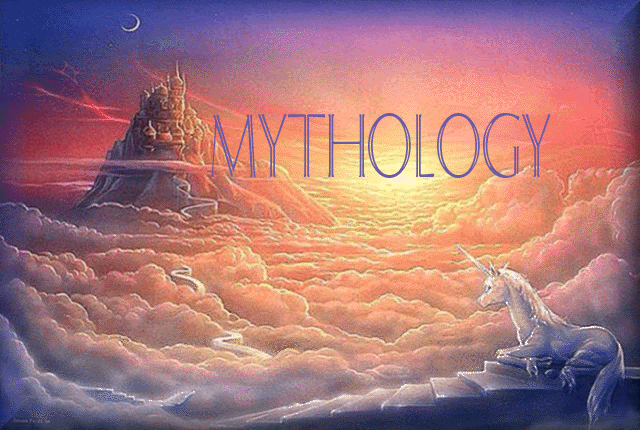

C. G. Jung described the collective unconscious as consisting of mythological motifs or primordial images to which he gave the name "archetypes". Archetypes are not inborn ideas, but "typical" forms of behavior which, once made conscious, present themselves as ideas and images, like everything else that becomes a content of consciousness. Archetypes have an organizing influence on images and ideas. Although not conscious, they seem to be like underlying ground themes upon which conscious manifestations are sets of variations. Their presence is felt as "numinous"; that is, of profound spiritual significance. Jung wrote:
All the most powerful ideas in history go back to archetypes. This is particularly true of religious ideas, but the central concepts of science, philosophy and ethics are no exception to this rule. In their present form they are variants of archetypal ideas, created by consciously applying and adapting these ideas to reality. For it is the function of consciousness not only to recognize and assimilate the external world the gateway of the senses, but to translate into visible reality the world within us.
All the planets, signs, gods and goddesses are within you and represent part of your eternal, archetypal self. When you make contact with a particular planet or mythological deity you are really making contact with part of your eternal self. What or who do you identify with?
When and if you finally stand in the presence of an archetype, the god or goddess will have something to say to you. (This is accomplished through techniques such as dream work, symbolic amplification, or active imagination.) If you have been drawn indirectly to this archetype by a dream or by intuition, you may simply open yourself to whatever the gods wish to tell you. Whatever happens, you will have made a living and vital contact with the world of the deities inside you.
It is not my endeavor to duplicate information already available on other websites concerning the subject of Mythology. (I have expounded on astrological myth on my Astrological pages; the page, located on "Insights", contains more in-depth information.) My intent is to explore those repetitive mythological figures that seem to have captured the imagination and interest of others via their art work or articles on the web.
Let me introduce you to:

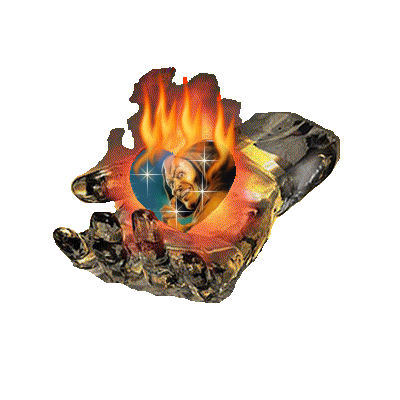

The Wizard - Magician |
(HERMES - THOTH) |
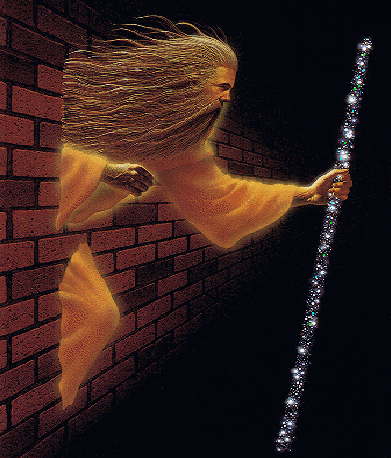 |
The Wizard - Magician - is symbolic of the four functions of the human psyche - intuition, feeling, thinking and sensation. Mercury (Hermes) the alchemist, has the ability to unite the elements into a single whole. Within each one of us exists an archetype Wizard. However, whenever we do admit to this kind of reality, we risk losing the empiric - which is our reason and rational mind - that has been built brick by brick throughout the centuries. The Wizard represents the conscious mind, which being concentration and single-minded attention to a specific idea or goal triggered by the imagination, can draw upon forces from above to help give it form and make it a reality in the material world. Jung called it "individuation". |
Perhaps this archetype symbolizes the discontent of many people who seek the answers to realizing their frustrated dreams and goals. Seeking mastery over the obstacles, one may ask: "What am I not doing right?"

MEDUSA (HECATE) |
(Ishtar - Mesopotamia) - (Inanna - Sumerian) |
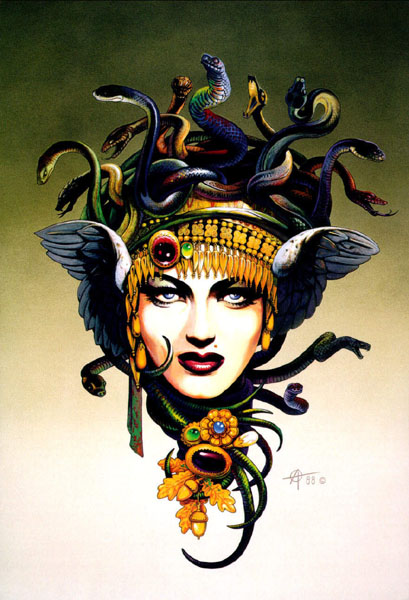 |
Medusa (Greek) had a mane of hair which was comprised of writhing serpents. She is the underworld queen - the female incarnation of Pluto and is typically a feminine archetype - a way of initiation for women. She represents the descent into the underworld (subconscious). The descent represents the acquisition of the "serpent wisdom", which is essentially feminine wisdom. It is symbolic of emotional death either through the death of a relationship, the loss of a job, the necessity to sell a beloved home and move to a strange place . . . the variations are endless. But one way or another, we are forced to give up something we thought we couldn't live without. Whatever the initial experience of loss may be, it sends us spiraling down, deep into the unconscious where we come face to face with our own personal demons. As we descend, we are stripped of our treasured belongings; material possessions, attitudes, cherished assumptions about life and we no longer have any sense of foundation, whether moral, emotional, or spiritual. At last we reach rock bottom and face that which we fear. Through the process of initiation (pain, grief, darkness) emotional resurrection is finally realized. |
I believe this archetype is indicative of the many single and unwed moms in our society who have suffered the disillusionment of their false dreams and expectations of life. Wiser for the experience, nonetheless, it leaves the heart feeling "old".

WOMAN IN GALAXY |
RETURN OF THE GODDESS |
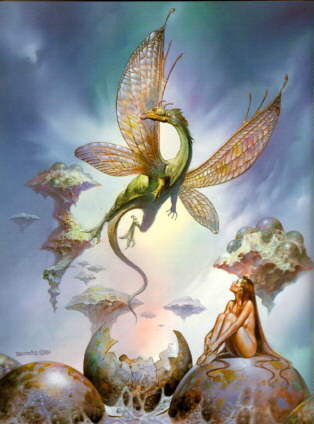 |
My interpretation of this picture would be "women" giving birth to children in the future who are different than children of past years. These children are very intelligent and seem to be on a mission. Their mode of reality is on a different dimension. They have their own mindset and do not like to be given unqualified orders. They have a short attention span and may become bored easily. Their minds need to be intellectually stimulated and they may have a preoccupation with computers, outer space and a natural understanding of the world as "one". The Indigo Children come to my mind (see website). Also, what role will women be assuming in the future? Will their ideas and insights be accepted by the world at large? Will they assume more executive roles on all levels of society and be accepted as an equals in governmental policy? |
Women participating in galactic affairs in the next millennium . . .

| DRAGON MASK | ADVENTURE INTO THE UNKNOWN |
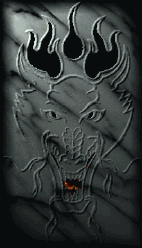 |
According to The American Heritage Dictionary Dragons are: n. 1. A fabulous monster represented as a gigantic reptile having a lion's claws, the tail of a serpent, wings and a scaly skin. 2. Archaic. A large snake or serpent. At best, they are magical, mystical creatures. Some say "Legend" - some say "Myth". They have a rich heritage that can be found in both Oriental and Medieval folklore. They (dragons) seem to have captured the imagination of our young society - there are over 5,000 websites presently! Their physiology seems to be a composite of the Fixed (Scorpio, Leo) - Cardinal Sign (Aries) and Mutable (Pisces) Astrological modes of energy representing powerful emotions, creation and enterprise, and spirituality, respectively. Dragons seem to project power, adventure, and uncharted dark places. |
This mask intrigued me. Upon reflection, perhaps it is similar to the Magician archetype inasmuch as it may symbolize the mastery and ability to project a powerful persona enabling one to obtain whatever is desired into the life.

SORCERER |
POSSESSION OF THE SPIRIT |
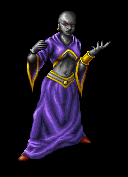 |
A sorcerer is someone who is considered to have supernatural powers over others through the assistance of evil spirits. Many unenlightened individuals include anything to do with the metaphysical, occult or esoteric sciences into the category of sorcery. People are prone to superstition when they do not understand a subject and will consider it evil and the work of the "devil". |
Perhaps the closest resemblance to the sorcerer would be someone who practices voodoo or black magic.

DEMETER |
EARTH GODDESS |
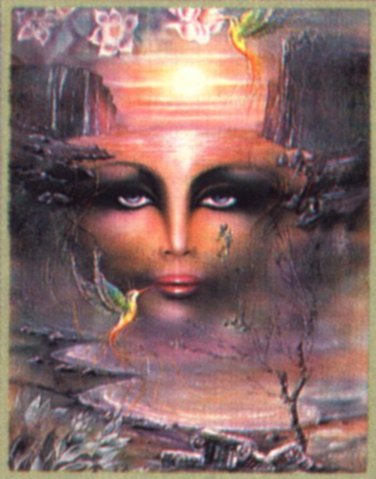 |
Demeter is the earth goddess who seeds the earth with fruit, flowers and grain to feed the hungry earth-children. According to myth, Kore, the maiden daughter of Demeter, was picking flowers in a field near Eleusis. All of a sudden, the ground opened up and she was seized by Pluto, lord of the underworld, who forced her against her will down to the land of the dead. Demeter went into a state of mourning, refusing to bear her fruit to the land. Humanity stood in danger of extinction. Moved by the prayers of mortals, Zeus sent Hermes into the underworld to beg for Kore's release. Because Kore had eaten seven pomegranate seeds, Pluto agreed to release her providing she spend three months of every year in the underworld. The remaining nine could be spent upon earth. (During her absence, the cold of Winter would reign). Kore would remain the dark lord's queen and her name would no longer be Kore, the maiden, but Persephone, - "she who is to be feared". Symbolically, when a mother is forced to sacrifice her child so that the child can fulfill its own destiny, she mourns her loss and suffers sadness. |
This archetype reflects the sadness and mourning of the mothers who have lost their daughters by abduction, bizarre actions of other children, rape and murder, etc.

ISIS |
VIRGO |
 |
The round of the seasons has always been symbolized in myth as a cosmic drama involving the Earth Mother and her child. More often than not, the child is male, and serves as the earth mother's lover as well as her son. In the Persephone myth, both key figures - mother and child - are female. To the Egyptians, Virgo was the goddess Isis with the sun-child Horus on her lap. Medieval Christians saw this same constellation as the Virgin Mary holding the Christ child; and rightly so, for the Christian story is simply the most recent version of the myth of the Great Goddess and her dying child. We live in an astrological age which is permeated with this myth, for Pisces is, in many ways, the dying god, while its opposite sign, Virgo, is the mother. When Michelangelo sculpted the Pieta, he created the mythic image for an entire cycle of history. |
This archetype may symbolize the pain and suffering of mothers who have lost their sons to the aids virus, murder, automobile accidents, and war.

ATLAS |
ONE OF THE TWELVE TITANS |
 |
The Greeks did not believe that the gods created the universe; it was the other way around. The universe created the gods. Before there were gods heaven and earth had been formed. They were the first parents. The Titans were their children, and the gods were their grandchildren. The Titans, often called the Elder Gods, were supreme in the universe for untold ages. They were of enormous size and of incredible strength. The most important was Cronus (Saturn) who ruled over the Titans until his son Zeus dethroned him and seized the power for himself. Saturn fled to Italy and brought in the Golden Age, a time of perfect peace and happiness which lasted as long as he reigned. Zeus punished his conquered enemies terribly. Atlas suffered a cruel fate by Zeus who condemned him to bear on his back forever the cruel strength of the crushing world and the vault of the sky. Bearing this burden he stands forever before the place that is wrapped in clouds and darkness where Night and Day draw near and greet one another. |
This mythical god represents the giants of "big business", government, law, military, religion, etc. who bear the burden of keeping their power and wealth.

PAN |
CHIEF OF THE LESSER GODS |
 |
Pan was the chief among the lesser gods of earth. He was Hermes' son; a noisy, merry god. Part animal, he had goat's horns and hoofs. He was the goatherds' and shepherds' god. He was also the companion of the woodland nymphs when they danced. All wild places were his home. He loved thickets and forests and mountains. He played sweet melodies as sweet as the nightingale's song on his pipes of reed and was always in love with one nymph or another, although he was rejected because of his ugliness. Sounds heard in a wilderness at night by the trembling traveler were supposed to be made by him, so that it is easy to see how the expression "panic" fear arose. |
Anyone you know?

SHAMAN |
NORTH AMERICAN PRIEST and HOLY MAN |
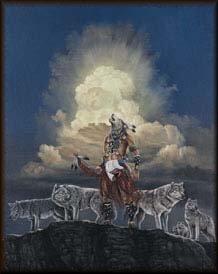 |
A Shaman was a holy priest and medicine man among certain North American Indian tribes. The religious practice of these native people embraced the belief that good and evil spirits pervade the world and can be summoned or heard through inspired priests acting as mediums. The male wolf is universally accepted as an image of Man, with reckless aggression and problems in sexual restraint. Considered a cunning, malicious predator, the concept of the wolf implies greed and hunger and in that sense - physical urges and dissatisfaction. In Steppenwolf by Herman Hesse, the wolf becomes a symbol for the lonely seeker (and sufferer). Here it is not so much a reference to the meanness of the wolf, but rather the lonely search for the meaning of life. Freud saw the white wolf as a "father" substitute after he had diagnosed a client's terrifying dreams about wolves as repressed desire for sexual gratification by his father to a fear of wolves. |
The search for sexual identification -

UNICORNS |
SOUL MATES |
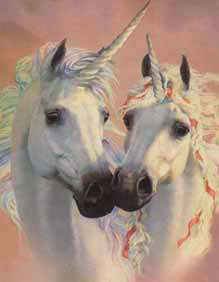 |
The Unicorn is an ancient symbol for innocence and purity. It places its horn in the lap of the virgin; it can't be caught in any other way. It is able to remove poison and its effects; it loves happiness. It may also be a sign of flight into an irrational fairy-tale world. Today, the unicorn also may mean hope of the removal of all differences (between the sexes) as well as fear of contradictions. Innocence and sexual urges are also connected to the image of the unicorn, and one may ask: "How do I see my desires without feeling guilty?" It is a question about the "purified animalistic self." According to Jung - it is the symbol of Self. |
Seeking the idealistic significant other . . . uniting mind, body and soul.

PEGASUS |
LOOKING THROUGH THE EYES OF PEGASUS |
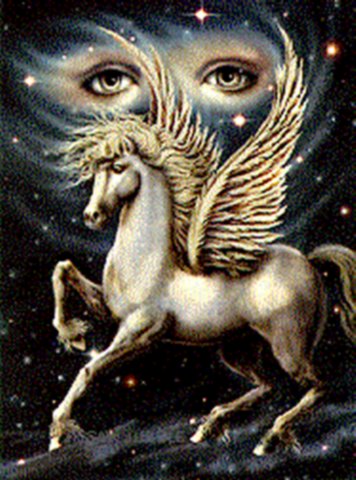 |
Pegasus was a winged horse who played a part in several legends, notably those of Perseus and Bellerophon. His name was supposed to be derived from the Greek word for "spring" and he was said to have been born at the springs of the Ocean (in the extreme west) at the time of the slaying of the Gorgon by Perseus. Some legends say that this divine horse had sprung from the Gorgon's neck. Other versions recorded that he was born of the earth, which was fertilized by the Gorgon's blood. After his birth, Pegasus flew up to Olympus and placed himself at the disposal of Zeus to whom he brought thunderbolts. Versions of the meeting of Bellerophon and Pegasus vary. Some said the goddess Athena brought the horse already broken in for Bellerophon to ride, or that Poseidon gave him to the hero, or that Bellerophon found him while drinking at the Pirenean spring. |
The Gorgon (Medusa) takes one to the very depths of his subconscious where he meets his demons. One by one, he must face issues of repressed fear, hate, anger and rage. Through the purging of his soul, he is enlightened and is able to send these issues to the surface of his consciousness where he is able to deal with these issues openly and rationally and thus rise above all past limitations just as Bellerophon had mounted Pegasus to kill the monster Chimaera.
